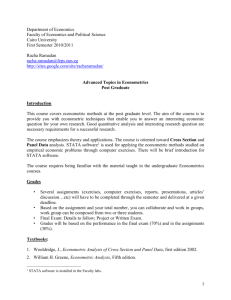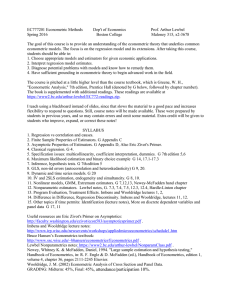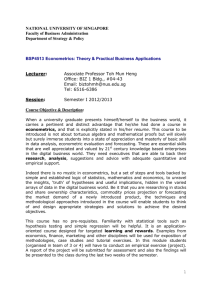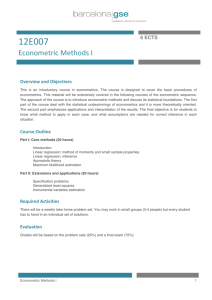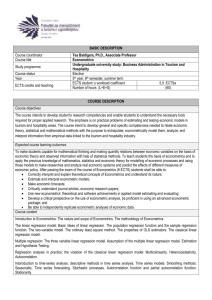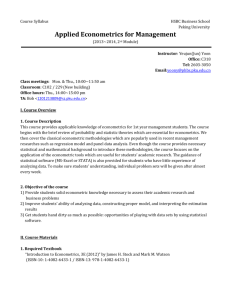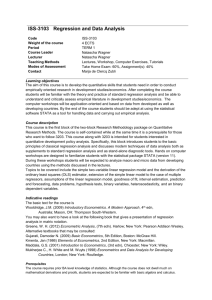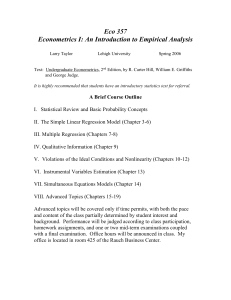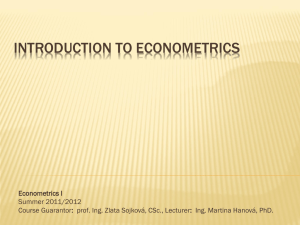Pre- requisite: Ag. Statistics (605150)
advertisement
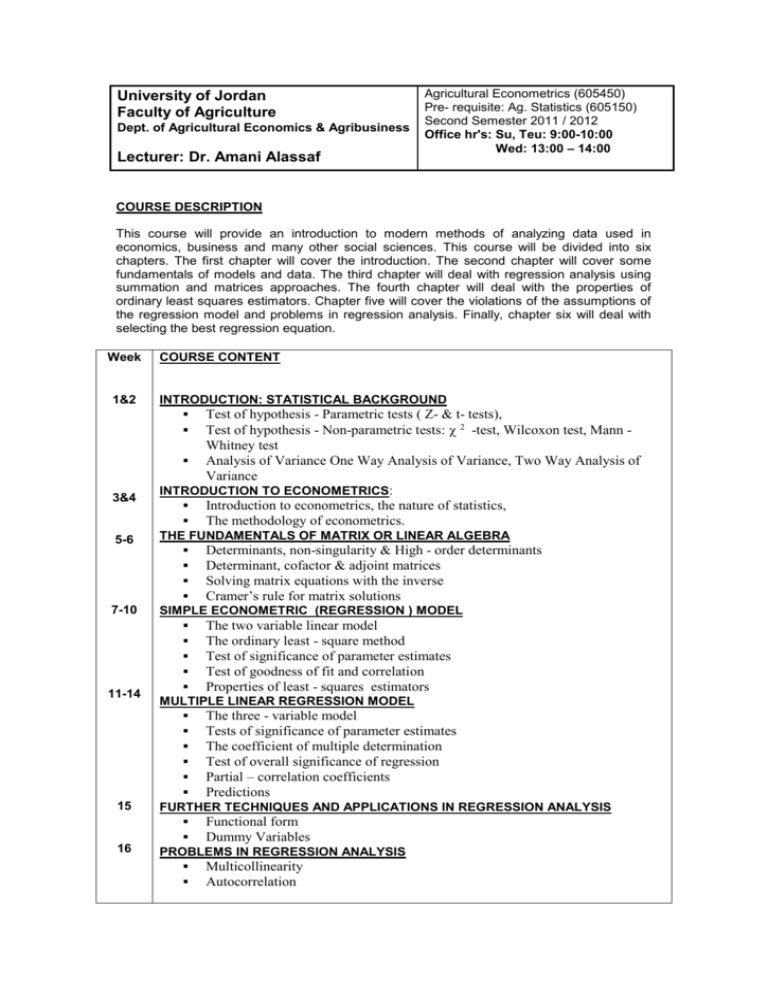
University of Jordan Faculty of Agriculture Dept. of Agricultural Economics & Agribusiness Lecturer: Dr. Amani Alassaf Agricultural Econometrics (605450) Pre- requisite: Ag. Statistics (605150) Second Semester 2011 / 2012 Office hr's: Su, Teu: 9:00-10:00 Wed: 13:00 – 14:00 COURSE DESCRIPTION This course will provide an introduction to modern methods of analyzing data used in economics, business and many other social sciences. This course will be divided into six chapters. The first chapter will cover the introduction. The second chapter will cover some fundamentals of models and data. The third chapter will deal with regression analysis using summation and matrices approaches. The fourth chapter will deal with the properties of ordinary least squares estimators. Chapter five will cover the violations of the assumptions of the regression model and problems in regression analysis. Finally, chapter six will deal with selecting the best regression equation. Week 1&2 COURSE CONTENT INTRODUCTION: STATISTICAL BACKGROUND Test of hypothesis - Parametric tests ( Z- & t- tests), Test of hypothesis - Non-parametric tests: 2 -test, Wilcoxon test, Mann 3&4 5-6 7-10 11-14 15 16 Whitney test Analysis of Variance One Way Analysis of Variance, Two Way Analysis of Variance INTRODUCTION TO ECONOMETRICS: Introduction to econometrics, the nature of statistics, The methodology of econometrics. THE FUNDAMENTALS OF MATRIX OR LINEAR ALGEBRA Determinants, non-singularity & High - order determinants Determinant, cofactor & adjoint matrices Solving matrix equations with the inverse Cramer’s rule for matrix solutions SIMPLE ECONOMETRIC (REGRESSION ) MODEL The two variable linear model The ordinary least - square method Test of significance of parameter estimates Test of goodness of fit and correlation Properties of least - squares estimators MULTIPLE LINEAR REGRESSION MODEL The three - variable model Tests of significance of parameter estimates The coefficient of multiple determination Test of overall significance of regression Partial – correlation coefficients Predictions FURTHER TECHNIQUES AND APPLICATIONS IN REGRESSION ANALYSIS Functional form Dummy Variables PROBLEMS IN REGRESSION ANALYSIS Multicollinearity Autocorrelation 2 COURSE OUTCOMES Successful completion of this course should lead to the following learning outcomes: A- Knowledge and Understanding ( students should ) A1) Be able to discuss/ explain the importance of a wide range of models and quantitative tools. A2) Be able to use econometric, statistical, and economic models as a basis for estimating key economic parameters, testing economic hypotheses, and predicting economic outcomes. B- Intellectual Skills- with ability to B1) Employ analytical skills to be used for data analysis. B2) Identify a range of statistical, economic, and econometric models and evaluate and justify them through suitable proposed solutions. B3) Analyze a wide range of econometric tools and provide solutions through suitable models. C- Subject Specific Skills- with ability to C1) Use appropriate econometric support tools. C2) Use the econometric scientific literature effectively. C3) Give technical presentations suitable for the time, place, and audience (students). C4) Prepare and deliver structural verbal and written technical reports or assignments. D- Transferable Skills- with ability to D1) Display an integrated approach to the development of communication skills. D2) Create self-reliance and team work when necessary. D3) Display personal responsibility to the course requirements. CLASS PARTICIPATION Students are expected to attend classes on time, and fully participate in class work and discussions. Your attendance is crucial, as each class builds upon the previous class session. Actual participation in class work is a very important part of your learning experience in this course, so you are expected to come and to be prepared to do the work, ask questions, and fully engage with the course. EXAMS AND GRADES Exam First Exam Second Exam Final Exam Grade Day Date 30 20 50 REFERENCES: 1. Gujarati, D. N., “ Basic Econometrics “, 3rd ed., McGraw-Hill Company Inc., New York, 1995. 2. Gujarati, D. N., “ Essentials of Econometrics “, McGraw-Hill Company Inc., New York, 1992. 3. Johnston, J. “Econometric Methods “, 2nd Edition, McGraw-Hill Book Co., New York, 1972. 4. Salem, M. A., “ Introduction to Agricultural Econometrics “, University of Jordan/ Faculty of agriculture, Amman, 1997 ( in Arabic ). 5. Salvatore, D. “Theory and Problems of Statistics and Econometrics” , Schaum’s Outline. 6. Series in Economics, McGraw-Hill Book Company, New York, 1982. 7. Wonnacott, R. J., and T. H. Wonnacott, “ Econometrics “, 2 nd ed., John Wiley & Sons, New York, 1979.


